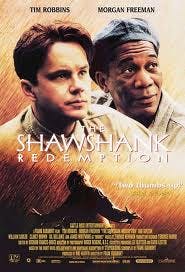Editor’s Note: Last year, TLNT asked some prominent thought leaders about their favorite films with a management or HR theme. With the Academy Awards taking place Sunday, we’re republishing the best of those posts all this week.
By Tim Sackett
There are only a handful of movies that I just can’t turn off when they come on, or that I would actually reach into the DVD collection to pull out and watch over and over. My official list of those are:
- Dumb and Dumber
- Talladega Nights: The Legend of Ricky Bobby
- The Matrix trilogy
- The Legends of the Fall (don’t judge me!)
- Gladiator (Again, don’t judge me, but it definitely seems like I have gay tendencies in movie selection and I see nothing wrong with that) – I also like Troy and 300!
On top of the list, though, has to be The Shawshank Redemption.
First off, Morgan Freeman is just ridiculously good in the movie as the character “Red,” and Tim Robbins plays the “Andy” character perfectly. I’m not going to run through the plot here, because I’m pretty sure everyone has seen the movie multiple times when it runs back-to-back-back on TBS or TNT or any one of the other cable networks that show it throughout the year. It’s genius.
The major theme of the film is “hope.” I think that fits well with us here in the HR world, because we tend to be the keepers of hope quite frequently throughout our careers. Whether it’s giving hope through the extension of a job offer, ensuring our employees about their future, or managing succession in our organization, “hope” becomes an overriding theme we hold dear in HR.

I’m always struck as well by Red when he is released from prison – after many decades of incarceration – and how in a very short time after being released, he comes to the point of wanting to commit suicide. This rings true in our profession in regards to how we move people within our organizations.
Think about it: how many times do we move great performers into positions where they fail? Too often! Yes, too often we make moves because we think that’s what the person wants and needs, even when they are completely “content” in the role they are in.
Personally, I’ve always connected with the film through its message of patience as well.
Throughout my career in HR, I’ve had one consistent learning that I’ve taken away from many events: those who have the most patience usually get what they want — both in business and in HR.
Not being someone who has “natural” patience, I’ve always been envious of Andy and his ability to put a plan in place, knowing it could take decades to reach its conclusion. Many of us in HR often get caught in “business cycle” planning – get things done in this business cycle and then move on to the new things in the next cycle. It’s all about ”show the business your value!”
What we tend to forget is that HR is an annual sprint to the finish line, and that great HR is a marathon of building a great people foundation over time – something that could take decades to perfect.
The trick in making your HR function great is that it’s not just about finishing projects and implementing the newest and greatest next “new” thing. It’s also about your ability, as a function of the business, to keep getting better over time – every day, every year. There isn’t a finish line in HR. We can always help our organizations get better, and we can always help our people get better, too.
I think Red said it best in the movie — we can all “get busy living or get busy dying.” Every day in HR, I choose to get busy living.
